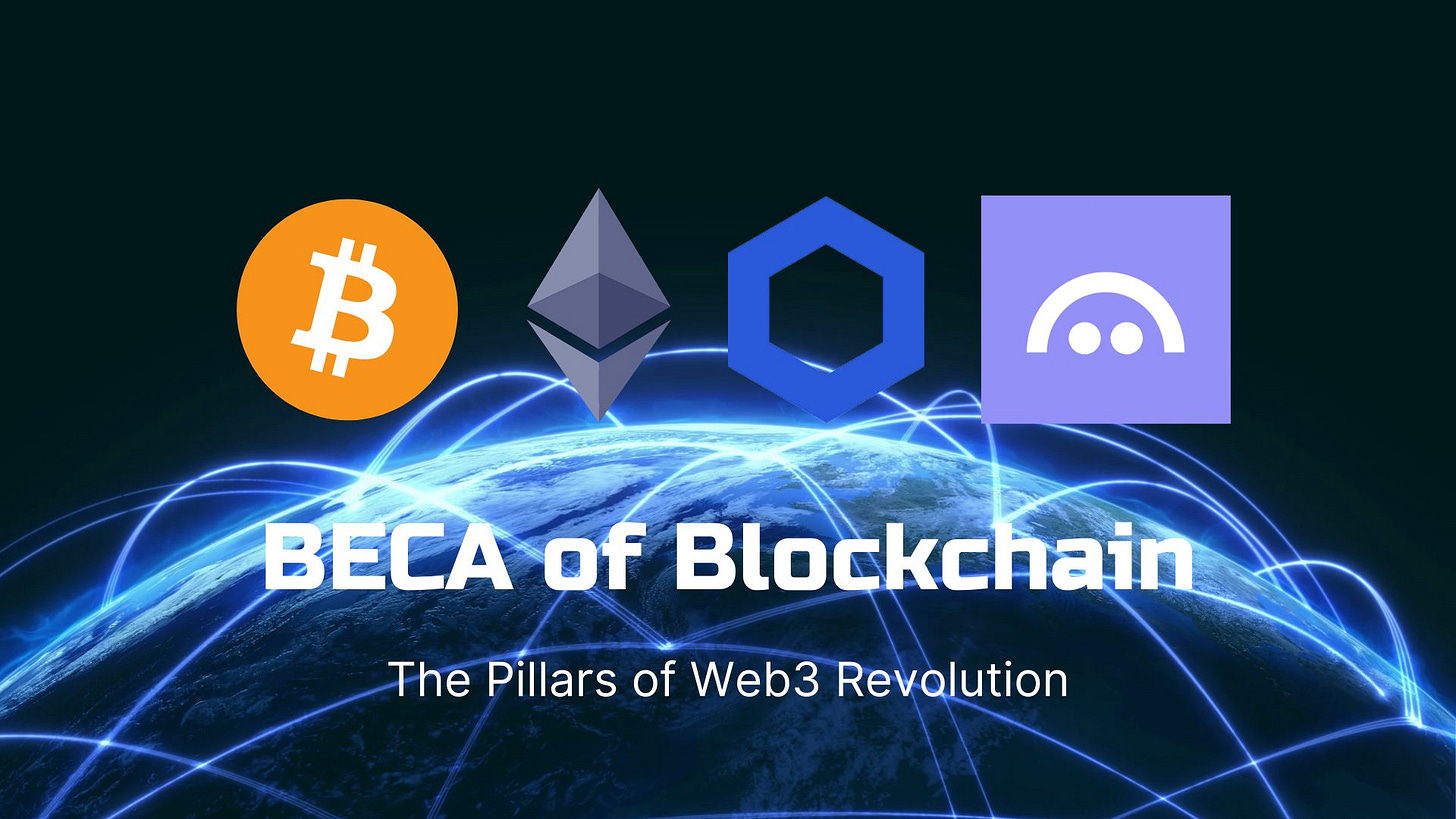The BECA of Blockchain: The Pillars of Web3 Revolution
In the traditional tech world, FAANG (Facebook, Apple, Amazon, Netflix, Google) represents the giants that transformed how we interact with technology. Similarly, in the blockchain space, we have BECA - Bitcoin, Ethereum, Chainlink, and Aave - four revolutionary protocols that have fundamentally shaped the decentralised landscape.
The Genesis: Bitcoin's Revolutionary Beginning
Our journey begins in 2008 when an anonymous figure known as Satoshi Nakamoto published a whitepaper that would change the future of finance. Bitcoin emerged in 2009, during the aftermath of the global financial crisis, offering an alternative to traditional financial systems. Unlike conventional currencies controlled by central banks, Bitcoin introduced a peer-to-peer electronic cash system that operates without intermediaries.
Bitcoin's true innovation wasn't just creating digital money - it solved the double-spending problem that had puzzled computer scientists for decades. Through its proof-of-work consensus mechanism, Bitcoin created digital scarcity, ensuring that each unit of Bitcoin couldn't be spent twice. This breakthrough laid the foundation for all future blockchain development, establishing concepts like decentralised consensus and immutable ledgers.
The Platform Revolution: Ethereum's Smart Contract Innovation
By 2013, developers realised blockchain technology could do more than just transfer value. Vitalik Buterin, a young programmer fascinated by Bitcoin's potential, envisioned a platform where developers could build any application on blockchain. This vision materialised as Ethereum in 2015.
Ethereum introduced smart contracts - self-executing programs that automatically enforce agreements. Think of them as digital vending machines: you input the required conditions (like tokens), and they automatically output the desired result (like a transaction or service). This innovation enabled developers to create decentralised applications (dApps) ranging from digital art marketplaces (NFTs) to complex financial instruments.
The missing piece was how these smart contracts could interact with the real world. Smart contracts, by design, are isolated from external data - they can't access real-world information like stock prices, weather data, or sports results. This limitation threatened to keep blockchain technology in its own isolated bubble.
The Oracle Solution: Chainlink's Bridge to Reality
Enter Chainlink in 2017. Founded by Sergey Nazarov, Chainlink solved what became known as "the oracle problem" - how to reliably connect blockchain with external data. Chainlink created a decentralised oracle network, where multiple independent node operators verify and deliver real-world data to smart contracts.
This breakthrough was crucial for DeFi's growth. Suddenly, smart contracts could access accurate price feeds, verify real-world events, and enable cross-chain communication. Chainlink's innovation went beyond simple data feeds - it created a framework for hybrid smart contracts that combine on-chain logic with off-chain data and computation.
Today, Chainlink secures tens of billions of dollars in smart contracts, providing essential infrastructure for thousands of projects. Its services have expanded beyond price feeds to include random number generation (VRF), automation, and cross-chain communication (CCIP), making it the de facto standard for blockchain oracle services.
The DeFi Pioneer: Aave's Financial Innovation
With Bitcoin providing digital value, Ethereum enabling smart contracts, and Chainlink ensuring reliable data, the stage was set for revolutionary financial applications. Aave, launched in 2020, showed how these technologies could transform lending and borrowing.
Aave introduced innovative concepts like flash loans and variable interest rates based on supply and demand. Unlike traditional banks that require extensive paperwork and credit checks, Aave's protocol enables anyone to lend or borrow digital assets instantly, secured by smart contracts and collateral.
One of Aave's most significant innovations was the introduction of decentralised interest rates. The protocol automatically adjusts interest rates based on the utilisation of lending pools - when more people want to borrow, rates increase to attract lenders, and vice versa. This creates an efficient market without any central authority setting rates.
The BECA Ecosystem: Greater Than the Sum of Its Parts
Together, these four protocols create a powerful ecosystem. Bitcoin provides the foundation of digital value and proves blockchain's viability. Ethereum offers a platform where innovation can flourish. Chainlink ensures these innovations can interact reliably with the real world. And Aave demonstrates how these technologies can revolutionise traditional financial services.
Looking ahead, BECA continues to evolve. Bitcoin is exploring Layer 2 solutions for scalability. Ethereum has transitioned to proof-of-stake and is developing solutions for greater scalability with numerous Layer 2 with affordable fees. Chainlink is expanding its services with Cross-Chain Interoperability Protocol (CCIP) to connect the TradFi and DeFi worlds. Aave is pioneering new financial products and expanding to multiple blockchains.
The BECA protocols show us that blockchain technology isn't just about cryptocurrencies - it's about creating a more accessible, efficient, and transparent financial system. Just as FAANG transformed how we interact with information and services, BECA is transforming how we interact with value and financial services in the digital golden age.
phuchoangle


